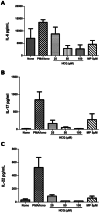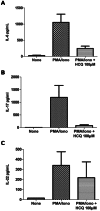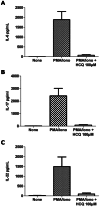Hydroxychloroquine decreases Th17-related cytokines in systemic lupus erythematosus and rheumatoid arthritis patients
- PMID: 23778483
- PMCID: PMC3674253
- DOI: 10.6061/clinics/2013(06)07
Hydroxychloroquine decreases Th17-related cytokines in systemic lupus erythematosus and rheumatoid arthritis patients
Abstract
Objectives: Hydroxychloroquine is an antimalarial agent that has been used in systemic lupus erythematosus and rheumatoid arthritis treatment for many years. Recently, novel mechanisms of action have been proposed, thereby broadening the therapeutic perspective of this medication. The purpose of this study was to evaluate the immunomodulatory activity of hydroxychloroquine in T helper 17 (Th17) cytokines in healthy individuals and patients.
Methods: Eighteen female patients with systemic lupus erythematosus (mean age 39.0±12.9 years) and 13 female patients with rheumatoid arthritis (mean age 51.5±7.7 years) were recruited from Universidade Federal de Pernambuco-Brazil. The patients were included after fulfilling four classification criteria for systemic lupus erythematosus or rheumatoid arthritis from the American College of Rheumatology. After being stimulated with phorbol 12-myristate 13-acetate and ionomycin in the absence or presence of different concentrations of hydroxychloroquine, the interleukin 6, 17 and 22 levels were quantified with an enzyme-linked immunosorbent assay in culture supernatants of peripheral blood mononuclear cells from healthy individuals and patients.
Results: We demonstrated that in peripheral blood mononuclear cells from healthy volunteers and in systemic lupus erythematosus and rheumatoid arthritis patients, there was a significant reduction in the IL-6, IL-17 and IL-22 supernatant levels after adding hydroxychloroquine. CONCLUSIONS Our in vitro results demonstrated that hydroxychloroquine inhibits IL-6, IL-17 and IL-22 production and contributes to a better understanding of the mechanism of action of this medication.
Conflict of interest statement
No potential conflict of interest was reported.
Figures



Similar articles
-
Th1/Th2/Th17/Treg cytokine imbalance in systemic lupus erythematosus (SLE) patients: Correlation with disease activity.Cytokine. 2015 Apr;72(2):146-53. doi: 10.1016/j.cyto.2014.12.027. Epub 2015 Jan 31. Cytokine. 2015. PMID: 25647269
-
Hydroxychloroquine Inhibits the Differentiation of Th17 Cells in Systemic Lupus Erythematosus.J Rheumatol. 2018 Jun;45(6):818-826. doi: 10.3899/jrheum.170737. Epub 2018 Mar 15. J Rheumatol. 2018. PMID: 29545450
-
Targeting the RhoA-ROCK pathway to reverse T-cell dysfunction in SLE.Ann Rheum Dis. 2017 Apr;76(4):740-747. doi: 10.1136/annrheumdis-2016-209850. Epub 2016 Nov 9. Ann Rheum Dis. 2017. PMID: 28283529 Free PMC article.
-
The Pharmacological Mechanisms and Therapeutic Activities of Hydroxychloroquine in Rheumatic and Related Diseases.Curr Med Chem. 2017;24(20):2241-2249. doi: 10.2174/0929867324666170316115938. Curr Med Chem. 2017. PMID: 28302011 Review.
-
Hydroxychloroquine: A double‑edged sword (Review).Mol Med Rep. 2025 Apr;31(4):102. doi: 10.3892/mmr.2025.13467. Epub 2025 Feb 21. Mol Med Rep. 2025. PMID: 39981928 Free PMC article. Review.
Cited by
-
Target in Sight: A Comprehensive Review of Hydroxychloroquine-Induced Bull's Eye Maculopathy.Curr Ophthalmol Rep. 2024 Sep;12(3):38-48. doi: 10.1007/s40135-024-00321-6. Epub 2024 Feb 23. Curr Ophthalmol Rep. 2024. PMID: 39371107 Free PMC article.
-
Augmenting regulatory T cells: new therapeutic strategy for rheumatoid arthritis.Front Immunol. 2024 Jan 23;15:1312919. doi: 10.3389/fimmu.2024.1312919. eCollection 2024. Front Immunol. 2024. PMID: 38322264 Free PMC article. Review.
-
Febuxostat therapy in outpatients with suspected COVID-19: A clinical trial.Int J Clin Pract. 2020 Nov;74(11):e13600. doi: 10.1111/ijcp.13600. Epub 2020 Jul 17. Int J Clin Pract. 2020. PMID: 32603531 Free PMC article. Clinical Trial.
-
Neuropsychiatric clinical manifestations in elderly patients treated with hydroxychloroquine: a review article.Inflammopharmacology. 2018 Oct;26(5):1141-1149. doi: 10.1007/s10787-018-0498-5. Epub 2018 Jun 9. Inflammopharmacology. 2018. PMID: 29948492 Review.
-
Role of topical and systemic immunosuppression in aqueous-deficient dry eye disease.Indian J Ophthalmol. 2023 Apr;71(4):1176-1189. doi: 10.4103/IJO.IJO_2818_22. Indian J Ophthalmol. 2023. PMID: 37026249 Free PMC article. Review.
References
-
- Katz SJ, Russell AS. Re-evaluation of antimalarials in treating rheumatic diseases: re-appreciation and insights into new mechanisms of action. Curr Opin Rheumatol. 2011;23(3):278–81. - PubMed
-
- Wallace DJ, Gudsoorkar VS, Weisman MH, Venuturupalli SR. New insights into mechanisms of therapeutic effects of antimalarial agents in SLE. Nat Rev Rheumatol. 2012;8(9):522–33. - PubMed
-
- Kyburz D, Brentano F, Gay S. Mode of action of hydroxychloroquine in RA-evidence of an inhibitory effect on toll-like receptor signaling. Nat Clin Pract Rheumatol. 2006;2(9):458–9. - PubMed
Publication types
MeSH terms
Substances
LinkOut - more resources
Full Text Sources
Other Literature Sources
Medical

